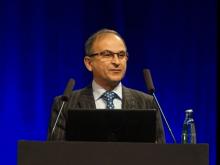PRAGUE – Adeno-associated virus (AAV)–based gene therapy is probably not the “endgame” in gene therapy for hemophilia, according to John Pasi, MD, PhD, director of the Haemophilia Centre at the Royal London Hospital.
“Gene therapy today is essentially gene therapy version 1.0,” Dr. Pasi said, kicking off the third day at the annual congress of the European Association for Haemophilia and Allied Disorders.
Interwoven with a summary of recent research and upcoming trends, Dr. Pasi reflected upon the medical community’s expectations for gene therapy, both past and present.
“For years,” Dr. Pasi said, “gene therapy has been regarded, essentially, as the Holy Grail of treatment for hemophilia.” This sentiment has been supported by the fact that hemophilia “is a single-gene disorder with a cause and effect relationship that is extremely clear and straightforward for us to recognize.”
A small increase in clotting factor can significantly reduce bleeding while providing a measurable efficacy outcome, making it a strong research candidate.
Looking back, however, when gene therapy research began in the early 1990s, it “really did go through a peak of inflated expectations,” Dr. Pasi said. “We thought for years it was just around the corner. But there were abject failures; there were learning curves we had to go through to understand many of the issues that gene therapy threw up, which we didn’t understand at the beginning.”
When this early excitement was met with tough realities, a period of disillusionment began and persisted through the early 2000s. Dr. Pasi suggested that this period of disillusionment may be reaching an end because of a “huge amount of steady work” that has ushered in a new period of productivity.
Dr. Pasi cited two 2017 studies published in the New England Journal of Medicine by Savita Rangarajan, MBBS, and colleagues and Lindsey A. George, MD, and colleagues for hemophilia A and B, respectively (N Engl J Med. 2017; 377:2519-30; N Engl J Med. 2017; 377:2215-27).
In contrast with previous studies showing factor levels in the single digits, recent studies have achieved normal-range values. Seeing such improvements in hemophilia A, is a particular source of optimism; historically, gene therapy for hemophilia A has lagged behind hemophilia B because of a larger gene that is more difficult to work with.
“This has stepped up the game hugely,” Dr. Pasi said.
The elements of gene therapy for hemophilia may change over time. For instance, lentiviruses could be used instead of AAV-based methods, and ex vivo techniques could make a comeback, potentially using different tissue sources. These changes are likely on the distant horizon, however.
Gene modification is also not coming anytime soon.
“Gene replacement, gene editing, and gene repair are something that we hear a lot about in the general field of gene therapy,” Dr. Pasi said, “But in practical terms for our patients, we probably are a significant way off from this at the moment, and this is because we know and we all recognize that there are a wide range of mutations causing hemophilia, and many of these are highly specific; we will need specific gene therapies to address specific mutations.”
Dr. Pasi likened the current state of gene therapy to that of the self-driving car, suggesting that “we still have strides to make, and there are still things we can improve on beyond what we have today.
“The biggest question for gene therapy today is durability,” Dr. Pasi said. “How long are these things going to last?”
Patients from earlier studies are now crossing the half-decade mark, albeit with relatively low factor levels, compared with recent techniques. One such study, presented at the 2018 annual meeting of the American Society of Hematology by Amit C. Nathwani, MD, PhD, and colleagues, is “very critical to our understanding,” Dr. Pasi said, referring to patients who are now 6-8 years post treatment. “What we see is … continued, stable expression of factor IX,” he said.
Alongside questions of durability, safety remains paramount in the quest for better methods of gene therapy.
“We are seeing liver function abnormalities,” Dr. Pasi said, noting that these tend to be transient elevations of ALT. “We know that many patients now have to receive steroid treatment, which very effectively reduces the immune response, but it is something that we are increasingly having to bear in mind.”
The latest techniques are using liver-specific promoters in novel synthetic capsids, and more capsids are under development.
Dr. Pasi also emphasized safety and caution. “We must never forget that gene therapy is a completely new approach to treatment, and we’ve got to think about safety. It is the number one priority when we are investigating new treatments.”
Safety remains untested in several key patient subpopulations, including children and those with comorbidities or inhibitors.
“For gene therapy in 2019,” he said, “we’ve made massive strides, but we’re not quite there yet.”

